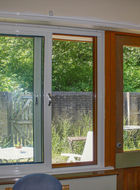Balancing Aesthetics, Safety and Security
17 Nov 2014Article taken from Health Estate Journal:
What trends have become apparent in the design of windows and doors for the healthcare sector in the last twenty five years, for example, with manufacturers responding to the particular needs and requirements of Estate Managers and other Healthcare specialists?
Window and door design has been revolutionised in the last twenty five years with thermal efficiency being the driving force behind advances in this area. Twenty five years ago windows were non thermally broken and aluminium doors were considered as industrial. By using gas filled double-glazing, special coatings for the glass and improved edge spacers we can minimise solar gain, reduce condensation, prevent air leakage and in general improve the comfort of the indoor environment.
In the healthcare sector, thermal efficiency has also driven design innovation, combined with the need to provide value for money. This is to be expected given the need of the sector to work within budgetary requirements whilst delivering a product that is fit for a specific purpose.
Over a period of time safety and security has become more and more critical. The increasing focus on health and safety and also the Disability Discrimination Act have been driving forces in developing window and door design.
Features that ensure the safety and protection of patients and staff are becoming increasingly important, calling for design that does not compromise on window or door performance and allows natural ventilation, but also offers a robust solution with built in safety creating a secure and comfortable environments for staff and patients. Rebated framed doors have been largely replaced with pivot hinged doors which are anti-finger trap, particularly aimed at protecting children. Main Entrance Doors are now frequently automated using sensors or remote push button operators in line with disability requirements. Contrasting coloured handles for doors have been introduced to aid those who are partially-sited.
However, sometimes products currently utilised are sometimes “over the top” compared to what is actually required and this can make a project very expensive. For example, within the mental health sector, windows that are designed for areas where self -harm could be a serious issue are also being used for low secure administration areas, adding unnecessarily to the overall budget.
At A.T.B. we have created windows to suit the different applications required for the healthcare and mental health sectors and offer a range that enables harmonisation of windows and doors throughout the building, but where the different requirements of each area can be met. For example administrative areas primarily occupied by staff can be treated differently to communal and individual patient areas.
How easy is it to produce windows and doors that meet healthcare requirements of minimising the build up of bacteria?
We have introduced the option of having our windows supplied with antibacterial glass which is a major innovation in combating hospital-caught infection. The special glass eliminates 99.9% of bacteria that form on the surface of the glass whilst also preventing the spread of fungi.
We can also supply our windows with integral blinds built into the double glazing which can be fully automated if desired. This has many advantages as the blinds cannot get dirty or dusty so cleaning is not necessary and the slats cannot get damaged. This facility offers additional privacy whether used for external or internal applications. The blinds can be tilted to regulate the level of light and heat entering a room, reducing glare and heat build- up.
Does the need for healthcare windows and doors to be robust and secure lead to a compromise in terms of aesthetics i.e. quality of finish and design?
Yes and No. Windows and doors used in healthcare need to be hardwearing, resistant and durable but these qualities can be designed into a window or door without compromising on appearance. This is also the case for developments which are primarily legislation driven. In fact, design features introduced to meet legislative requirements have resulted in an increase in the quality of windows and doors.
Paradoxically, in many ways aesthetics have been improved. We now have the option of a wide range of colours for our window and door frames and aluminium windows offer the opportunity to use different colours on the inside and outside faces, thanks to thermal break, which was not an available 25 years ago.
Who do you think is the driving force in identifying requirements for windows and doors used in healthcare applications?
Although the government is the driver behind the key requirements for the design of windows and doors, Local Authorities, Stakeholders, Estate Managers and Clinical staff, or a combination of all of these will have different viewpoints on the most important criteria to suit their individual projects. For the Clinical staff the safety, security, comfort and general well being of their patients is the driving force, whereas the Estates team will be looking at budgets and performance. At ATB we believe it is important from the outset to discuss specific needs and constraints with all parties.
What do you think are the key criteria for Healthcare personnel when purchasing windows and doors?
We have identified that cost is a key consideration, particularly to the Estates team, but up until recently there has not been a great deal of choice regarding product selection. As an industry we need to make everyone aware that other options are available particularly when, for example, fifty percent of a building does not necessarily require an anti-ligature solution. The potential cost savings could be enormous.
Cost will always be an important factor in purchasing windows and doors, but safety and aesthetics come a close second.
Is it more difficult now with that the traditional, multi-bed ward has been replaced by smaller wards or individual rooms?
For new build there is little difference to us as we always work to the requirements of our customers. However in refurbishment project the unit will usually remain operational during the installation period and as a result we have to be aware of the clinical staff and patient needs.
In the case of individual rooms we need to be flexible as schedules often need to be altered according to the patient and often installation ends up in a different sequence the original plan, which is an important consideration. Work also needs to be carried out quickly to cause as little disruption and distress to the patient as possible. Particularly in the case of metal health applications it is often necessary to complete the installation in a day so the room occupant does not need to be moved elsewhere overnight.
Who are the main stakeholders that tend to specify windows and doors in the healthcare sector?
Generally this decision is made by the local Health Authority/NHS trust, however particularly in the case of new build it is carried out by the Health Authority in conjunction with the architects on the project.
As we have noted earlier there are different requirements to be met in terms of value for money, performance, security, safety and aesthetics with priority assigned differently according to the roles of those in the decision making process.
Is there much difference between the demands of the private and public sector?
All projects that have public access are subject to the same legislative requirements and we see no difference between the public and private sector in this respect.
In terms of quality, value for money and performance of product, as you would expect, both the public and private sector have the same requirements. Our aim at A.T.B is to provide quality products combined with excellent personal service and to exceed our customer’s expectations.


